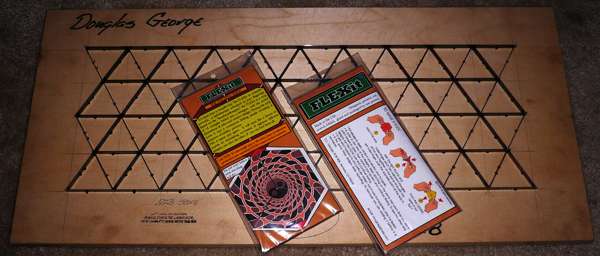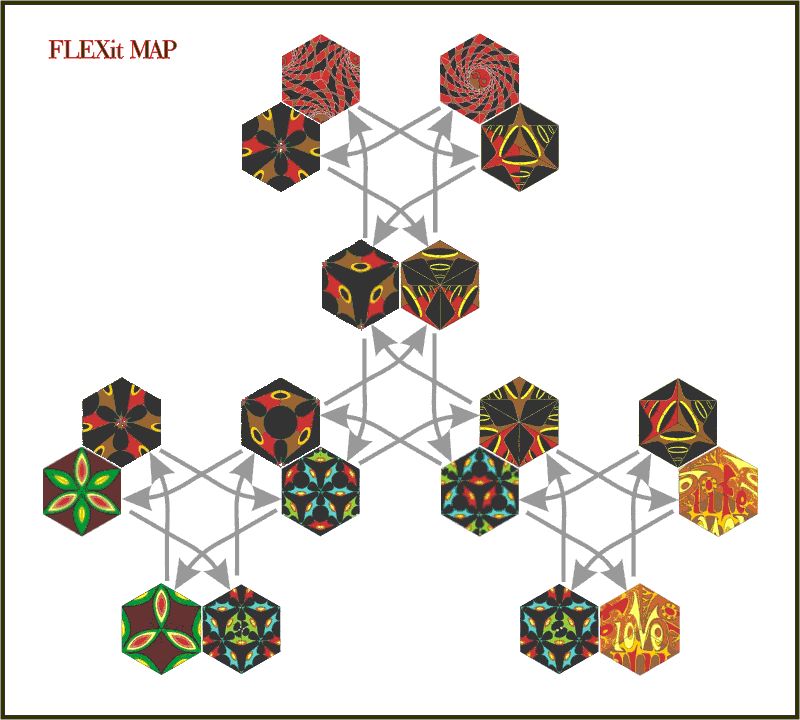MY FLEXAGON
dcgeorge.com
The personal website of Douglas C. George.

|
MY FLEXAGON |
dcgeorge.com |
The personal website of Douglas C. George. |

|
|
|
The flexagon was invented in 1939 by A. H. Stone, a graduate student at Princeton University. Stone first discovered the trihexaflexagon and then, along with a small group of his classmates that included Richard Feynman, Bryant Tuckerman and John W. Tukey, further developed the idea into the full hexahexaflexagon. Most of what is known about the flexagon was laid out by this group during their Flexagon Committee meetings.
In 1956 Martin Gardner wrote about the flexagon as the subject of his first article for Scientific American and later wrote a book entitled Hexaflexagons and Other Mathematical Diversions, University of Chicago Press.
The flexagon is usually made from a strip of paper divided into triangles and folded into an arrangement similar to a Mobius strip only with more twists. When flexed, it turns inside out with the triangular surfaces combining in various ways. Flex it again and again and it will continue to open like a flower to form an astonishing sequence of eighteen different combinations.
I first became addicted to the Flexagon in the early seventies. Several times over the intervening years I have marketed artistic version of it. The latest version was called the FLEXit and was designed, printed, cut, folded, packaged by hand and marketed locally by me alone. They sold well but were too difficult to make on a small scale.
Here are a couple of photos of the FLEXit.
|
|
And a photo of its packaging on top of a die for cutting and scoring.

In spite of its obvious potential, as far as I know, the Flexagon has never been successfully marketed on a large scale. The main reason for this is that it must be folded into its final shape by hand, a process that is complicated and time consuming. A machine to fold them automatically has never been built. However, I have designed a folding machine to do just that. If anyone is interested in large scale production and marketing of the Flexagon and has a bundle of money to do it, please feel free to contact me by email.
|
How to flex a Flexagon. I've included it here because most of the instructions I've seen are not very clear. Please note: The email address shown here isn't up to date. |
|
|
The Flower, a two-way design, comes up as a three-petal flower or a six-petal flower. This design was made by my friend Phil Lutz many years ago. His colors were different. |
|
|
Life/Love, another two-way design, incorporates words as well as geometric shapes. |
|
|
The Yin Yang Spiral, the last of the two-way designs, is based on an optical illusion that's been around for a long while. I don't know who made the original optical illusion. The thorny spiral is actually a series of concentric rings. |
|
|
Amoeba Dance is one of three four-way designs. Note that the two right-most images have different centers. |
|
|
Cellular Network, another four-way design, is, as you can see, a variation on the previous face using the same basic shapes only smaller and more of them. |
|
|
Yellow Hoops is the last of the four-way designs. Note that, in the rightmost image, three of the hoops are completely enclosed in red. |
|
Here is a complete map of the FLEXit with images of all eighteen configurations
 .
.
The images are coupled in pairs that show the front and back sides of the flexagon for each possible configuration.
The grey arrows show the results of flexing a face without turning it over.
This ingenious triangular layout for the map was created by my friend Stephen Anthony Malinowski. The three two-way faces occupy the apexes of the triangle with the three four-way faces forming arc-like connections between them and each other. I find the revealing symmetries presented in this diagram to be immensely satisfying as well as informative. Many thanks to Stephen for this remarkable arrangement.